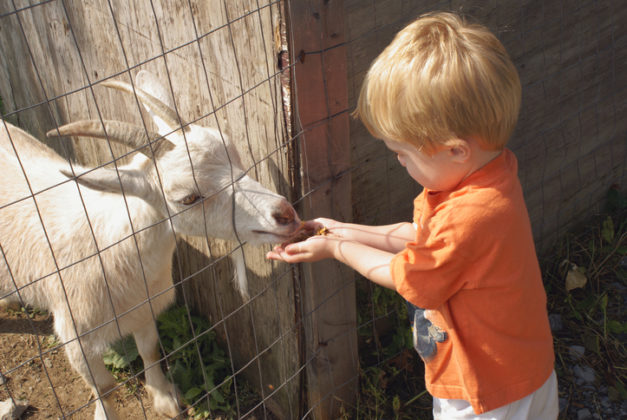Our children’s interactions with animals are one of the only dynamics in their lives where they clearly have status and a degree of power.
In the face of the #MeToo movement many parents are taking a stronger stance against the mandatory physical affection that often comes with holiday visits. We are becoming conscious that forcing our daughter to unwillingly hug grandma reinforces the harmful idea that it’s sometimes more important to keep the peace than to maintain control of our physical space. To combat these insidious notions, some parents are now actively supporting their child’s rights to bodily autonomy in the hopes that their child will feel empowered to enforce their own boundaries as adults.
The other side to teaching consent is making sure that our children respect the boundaries of others, particularly those that are less powerful than they are. For this lesson, I believe many parents (historically myself included) inadvertently send the wrong message in terms of how we allow our children to interact with animals.
My family was recently at a Christmas party with a small petting zoo. The pen was clean and the animals were quiet, but it was a sad scene nonetheless. An alpaca and two sheep were huddled together in a corner, as far away from the entrance as possible. A small child was chasing a duck around the pen. The child wasn’t being mean-spirited but the animals were clearly miserable and no adult was intervening.
Many people object to petting zoos because they can be cruel to the participating animals. In my mind it goes beyond that—allowing this behavior teaches our children the following harmful lessons about the boundaries of others:
Being passive is the same as giving consent. Debates around spectacles like petting zoos often center on how the animals are acting. If the goats and sheep are passive, adults interpret this as the animals “not minding” their predicament. The problem is, both animals and people may sometimes be passive not because they agree to physical touch but because passivity feels like their best defense.
Consent only occurs when a person or animal has the option to say “no” without fear of repercussion. In the case of the petting zoo, this means animals must have a safe area which is off limits to humans. If the animals do not have this recourse, we should leave them alone. This lesson is a building block toward children understanding not to take advantage of vulnerable people, whether that vulnerability be physical, emotional, or financial.
The aggressor’s feelings are more important than the object of their attention. In the past I allowed my son into petting zoos because he loved the interactions and in the absence of any obvious signs of mistreatment his joy trumped any reservations I had about the animals’ situation. Many other parents adopt this same rationale. It’s the same thinking that for so many years led people to force their children to unwillingly hug relatives. No one wants to hurt grandma’s feelings; no one wants to deny their child a chance to express their love for animals.
However, the truth is that a child’s disappointment at not being allowed to pet a horse is irrelevant to the question of whether the behavior is acceptable or not. Relying on this excuse is in the same vein as a man justifying rape because he is biologically wired to crave sex with women. The behavior is OK if the aggressor needs it or enjoys it enough.
We have to teach our children that their preferences don’t matter if their actions infringe upon another person or animal’s rights. It’s OK if they have a cry when being pulled away from the petting zoo. What they learn is far more important than what they miss.
Consent is moment to moment. My family recently adopted a puppy. She is boisterous and affectionate and loves jumping into my son’s lap for snuggles and rough housing. He adores her.
Where we sometimes have a problem is when the puppy gets tired. She tries to jump off his lap and he restrains her by pulling her into a bear hug. He is gentle, but that’s not the point. The point is that the puppy no longer wants the contact she initiated just a few minutes earlier. Teaching him to respect her change of heart takes a lot of reinforcement.
Conceptually, teaching a child that behavior which is encouraged in one moment is no longer acceptable in another is tricky. Children see black and white much easier than gray. Sadly, it’s obvious that many men in our culture never really master this lesson in the context of sexual relationships. So for my son we’re starting early, with his puppy.
I know that many people will react to my points by arguing that the linkage between a child’s innocent behavior and future actions is overblown. Make no mistake, I am not suggesting that a child who is allowed in a petting zoo is destined to be a sexual predator. I am also not advocating that animals be given the full rights of a person.
However, I am saying that our society is overflowing with the wrong sorts of messages for our children. Feminine and masculine stereotypes are embedded in every fiber of our culture. Violence is a way of life. Our children’s interactions with animals are one of the only dynamics in their lives where they clearly have status and a degree of power. As such, the situation is ready made for us to teach them a very intentional lesson about autonomy and respect. We have to take advantage of these opportunities.
Anne Penniston Grunsted writes about parenting, disability, and family life from her perspective as a lesbian mama. She lives in Southern California with her wife and son. Read more of her writing at annepennistongrunsted.
Other Links:

